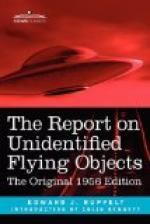About this time the official Air Force UFO project had one last post-death muscular spasm. The last bundle of reports had just landed on top of the pile in the storage case when ATIC received a letter from the Director of Intelligence of the Air Force. In official language it said, “What gives?” There had been no order to end Project Grudge. The answer went back that Project Grudge had not been disbanded; the project functions had been transferred and it was no longer a “special” project. From now on UFO reports would be processed through normal intelligence channels along with other intelligence reports.
To show good faith ATIC requested permission to issue a new Air Force-wide bulletin which was duly mimeographed and disseminated. In essence it said that Air Force Headquarters had directed ATIC to continue to collect and evaluate reports of unidentified flying objects. It went on to explain that most UFO reports were trash. It pointed out the findings of the Grudge Report in such strong language that by the time the recipient of the bulletin had finished reading it, he would be ashamed to send in a report. To cinch the deal the bulletins must have been disseminated only to troops in Outer Mongolia because I never found anyone in the field who had ever received a copy.
As the Air Force UFO-investigating activity dropped to nil, the press activity skyrocketed to a new peak. A dozen people took off to dig up their own UFO stories and to draw their own conclusions.
After a quiet January, True again clobbered the reading public. This time it was a story in the March 1950 issue and it was entitled, “How Scientists Tracked Flying Saucers.” It was written by none other than the man who was at that time in charge of a team of Navy scientists at the super hush-hush guided missile test and development area, White Sands Proving Ground, New Mexico. He was Commander R. B. McLaughlin, an Annapolis graduate and a Regular Navy officer. His story had been cleared by the military and was in absolute, 180- degree, direct contradiction to every press release that had been made by the military in the past two years. Not only did the commander believe that he had proved that UFO’s were real but that he knew what they were. “I am convinced,” he wrote in the True article, “that it,” referring to a UFO he had seen at White Sands, “was a flying saucer, and further, that these disks are spaceships from another planet, operated by animate, intelligent beings.”
On several occasions during 1948 and 1949, McLaughlin or his crew at the White Sands Proving Ground had made good UFO sightings. The best one was made on April 24, 1949, when the commander’s crew of engineers, scientists, and technicians were getting ready to launch one of the huge 100-foot-diameter skyhook balloons. It was 10:30A.M. on an absolutely clear Sunday morning. Prior to the launching, the crew had sent up a small weather balloon to check




